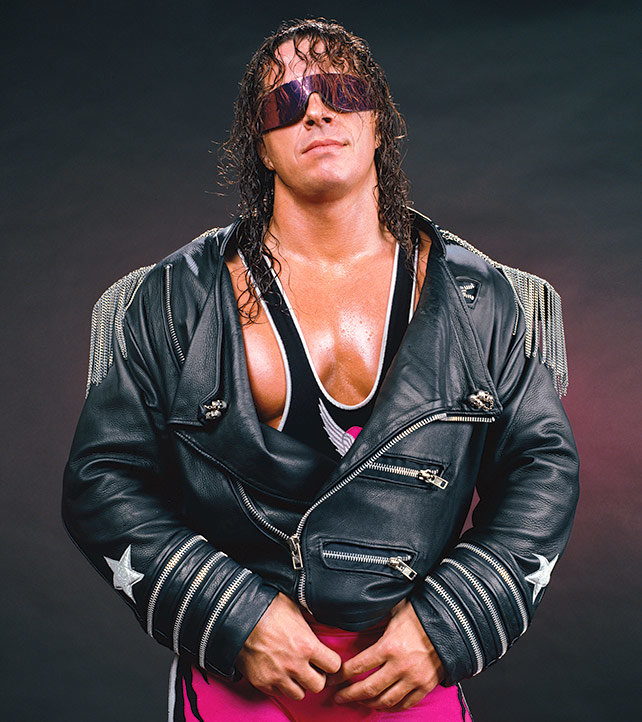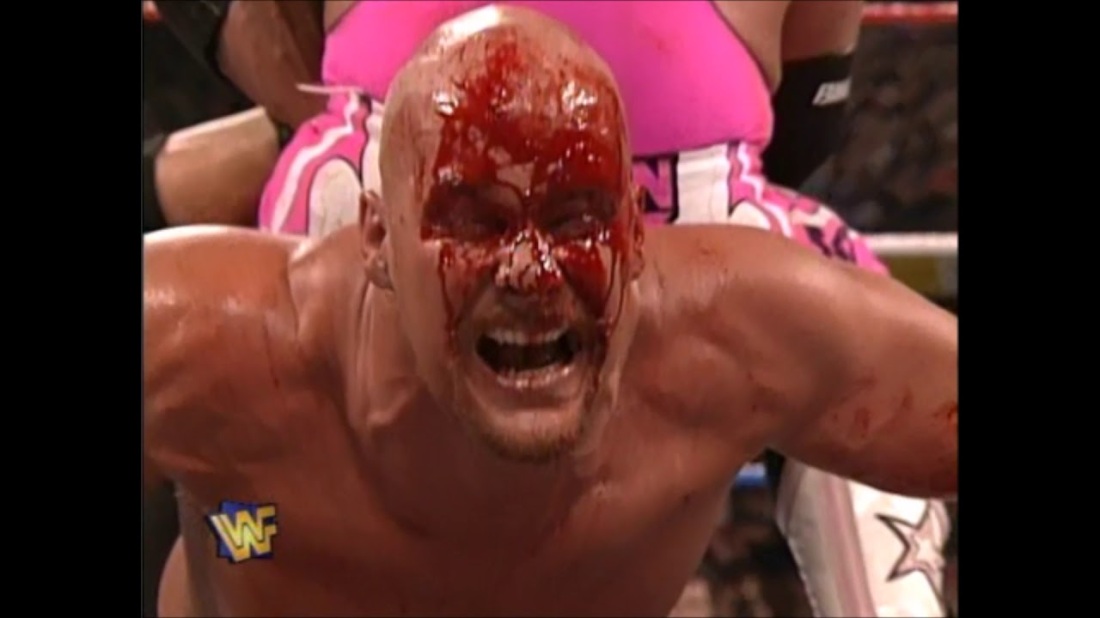If you’re in your mid/late twenties as you read this, the chances are you probably caught on to professional wrestling slightly before or during the attitude era, and what a time to catch on, right? Bikini contests, racially charged story lines, and genitalia references aside; it was a three year period where the popularity of “Sports Entertainment” was at such a level so high – that the smart money suggests it will never be replicated again.
Whether or not the attitude era ended up being a good thing for the business in retrospect is an argument for another day. The fact remains that looking back, car crash TV was entertaining, and boy did we have the perfect roster to dish out the mayhem.
Sitting as somewhat of an on-looker to the most profitable era in wrestling was Bret Hart, who left the then WWF for Ted Turner’s WCW just as the term ‘attitude’ was starting to be coined. Despite being a solid main event player in 1997 when WWE/F began to turn up the risque factor in their programming – the Hitman is rarely associated with the era, mostly because of his departure from Titan tower but also because of WCW’s vastly underwhelming use of the Canadian.

As a result of the watered down version we received of Bret Hart from Ted Turner’s organisation, you could easily be fooled into thinking that the Hitman didn’t play a pivotal role in turning WWE into the global phenomenon it is today; you’d be wrong. In fact, Bret Hart is probably the most important wrestling figure we have ever come across. Austin, Rock, Hogan, Flair, Sammartino, Michaels, The Undertaker, he was more important than them all. Bret is often referred to as one of the greatest of all time, but even that moniker doesn’t do his tenure in the business justice.
It seems like a life-time ago, but when Bret made his arrival into the WWF the company, and the world were stuck in Hulk Hogan’s craze of eating vitamins and saying prayers. And Vince McMahon’s mathematics for success were simple: build up a super heel who will eventually be fed to Hogan’s leg drop. You can question the Hulkster’s work rate all you want but the fact is, it worked, and from 1985-1991 Hulkamania was the cash cow that took professional wrestling from mostly regional, to worldwide.
But while Hogan was the undoubted face of the company, Bret was putting in excellent work in the tag team division with his brother in law Jim ‘The Anvil’ Neidhart. Themselves as well as talents such as Ricky Steamboat, Randy Savage, Mr Perfect, and Shawn Michaels etc were starting to put together athletic, captivating performances that were consistently far out shining the main event in terms of entertainment value; a concept that would pay dividends in the years to follow.
Fast forward to the early 90’s and wrestling was nowhere near as hot as it was just a few years prior. WrestleMania wasn’t drawing 70,000 plus into stadiums anymore, and interest around the product in general seemed to be on the decline. The industry wasn’t quite in danger of going out of business – but pro-wrestling was no longer a worldwide sensation.
This was thanks in part to a mass of steroid allegations that surrounded both Hulk Hogan and Vince McMahon – something VM was very nearly imprisoned because of. Wrestling needed a new, squeaky clean hero for people to believe in once again – someone who could carry the ball for the company without looking like Mr Olympia.
As it turns out – they had the perfect man for it, by 1992 people had bought in to the character of Bret Hart. By no means the most charismatic, or particularly flamboyant – Bret was respected solely because of his ability to tell you a story in the ring. And its these chapters in the history of pro-wrestling which define the Hitman as the most important wrestler there ever will be.

When the interest in the product was declining, and the perception of the industry was in doubt; Bret Hart was the courageous knight that kept people invested at a time when WWE was struggling financially. Incredible feuds with Mr Perfect, his brother Owen, and British Bulldog to name a few, allowed fans to invest in the concept of two talented workers taking you through twists and turns until an unpredictable climax, no “Hulk Up’s” necessary.
The pink attire, passing his sunglasses over to children in the crowd, his enigmatic entrance music, and his flawless ability in the ring: Bret Hart was everything that WWE needed at the time. Was the company roster filled with other talented individuals? Undoubtedly yes, but none of them could hold a candle to Bret’s ability to deliver the whole package in a believable manner. He was the very depiction of the people’s choice.
It could even be said that of all the “faces” of the company over the last 40 years, none of them had a job as difficult as Bret. Look at it any way you’d like, the fact is that Bret Hart was a draw at a time when people had started to turn their backs on wrestling, and the fans that stayed were ones that had bought into the art form of the sport. You could argue that Hart single handedly ushered in the era where the most talented, not necessarily just the biggest, got the chance to run with the ball.
Despite his massive contributions and importance to the industry in the early 90’s, Bret’s coup de grace in pro wrestling was to come between 1996/7. As we look upon the sport in 2018, we can all but accept that kayfabe is dead, and for better or worse we understand the workings of the business on a huge scale, nothing is a secret anymore. As a result of this – as fans we now realise just how important it is for wrestlers to “make” their opponent when the time is right, and Bret did one mighty job of making two of his opponents in the late 90’s.

His iron-man match with Shawn Michaels in the main event of WrestleMania 12 for the WWE championship was 60 minutes of wrestling to an incredible standard. Before this point, Shawn was looked at as a phenomenal talent with a strong following; but would he ever be ready to hold the mantle of being “the guy”? It took one hour of vigorous, exhausting story-telling in the ring for you to be convinced that Michaels was the right guy for the title.
Shortly following WrestleMania 12 was when WWE were faced with another financial challenge. Ted Turner’s WCW were acquiring former Vince McMahon talents left, right, and centre, and the NWO story-line had taken over wrestling. For the first time in his life, Vince McMahon was sitting in second place to another wrestling organisation – and the future of the company was once again in doubt.
It would be on one fateful night in Chicago that Bret Hart would make yet another, and possibly his greatest contribution to professional wrestling. Stone Cold Steve Austin, you’ve probably heard of him – from mid 96 to early 97 the Texas rattlesnake had put in heel work of such high quality that fans had actually begun cheering him (an unusual concept in pro-wrestling at this time). His tough guy persona, aggressive in ring style, and fresh mic skills saw him turning into quite a fan favourite.
By the same token; Bret’s shining light persona had started to lose some of its shimmer, it was time to freshen things up, and thus: the cards were set for the greatest double turn in the history of wrestling. To perform a match where the heel and face switch roles is a daunting task for anyone who has ever set foot inside the squared circle, but it just so happens that Bret and Austin were going to do so in one of the great matches of all time.
No one could have foreseen that a simple submission match between the two at WrestleMania 13 would change the business in the way that it did. Go back and watch that match, the crowds investment into the two wrestlers is beyond captivating, and if “Sports entertainment” is the descriptive phrase we need to coin when describing wrestling in this day and age; this match was the perfect example of what it could be.
The two managed to execute a performance that looked like a legitimate fight all with the entertainment thrills and spills you’d come to expect from wrestling. The image of the blood pouring down Austin’s face while Hart attacks his legs with a chair somehow made you feel empathy for a man that had never showed it for anyone else – deep down you wanted him to overcome this obstacle.
But if we’re discussing imagery, there will possibly never be a better image in the history of wrestling than the one that appears at the climax of this match. As Bret Hart has Stone Cold locked in the sharpshooter while the camera pans to Austin screaming with blood running down his face and through his teeth – it sends shivers down the spine. You know how it ends, Austin doesn’t submit but does pass out from the pain, Bret continues the assault after the match, the fans boo Bret, and cheer for Austin when he drags himself to his feet. And there it is: Stone Cold turned face setting him up for arguably the greatest run in wrestling history.

When you look into the folklore of wrestling, this match will be mentioned every single time, and so it should. It was one of the greatest matches of all time that cemented the biggest superstar in history as the guy you could finally cheer for. It’s been talked about to death but when you break it down – Bret Hart was the only man suitable for the role of turning Austin into the good guy; proving he was the excellence of execution.
What followed for Bret was a successful heel run leading the Hart Foundation faction into Survivor Series 1997, you already know what went down in Montreal on that night, but if you don’t: Google “Montreal screwjob” it makes for some fascinating reading.
The attitude era was started at the behest of Shawn Michaels, and Stone Cold, and while Bret’s actual contributions to the era were minimal; it can’t be argued that both Michaels and Austin had reached their star status as a result of their work with the Hitman. And that was the Canadian’s best attribute: his ability to make whoever he was in the ring with look like a legitimate star.
Would we have still seen an attitude era without Bret Hart? Possibly, but whether the era itself would have been anywhere near as impactful can certainly be debated. To put it simply, Bret Hart was the Stretch Armstrong figure that held the company together through the dark times and pulled Titan Tower into a new age of professional wrestling.
When you consider the Mount Rushmore of the industry, and you ask who played the largest roles in making the sport what it is today – it seems harsh to only be able to name four. The star power and mainstream attention generated puts Hogan and Austin on there without question, Ric Flair makes the cut for his sensational work in the 80’s, and the last space belongs to Hart. WWE’s burning light when times were at their darkest; he simply was: the best there was, the best there is, the best there ever will be.